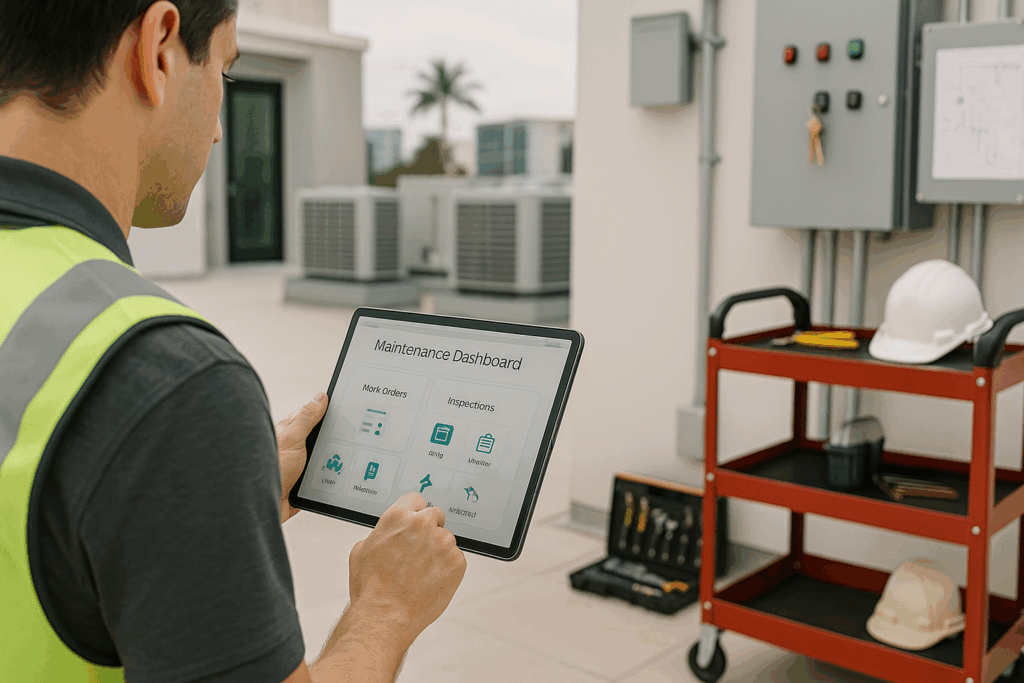
Property Maintenance Services Essential for Efficient Building Management
Property maintenance services encompass a range of tasks designed to keep buildings safe, functional, and attractive. These services address repairs, cleaning, and upkeep to ensure properties remain in good condition and meet the needs of tenants or owners. Effective property maintenance directly impacts tenant satisfaction, property value, and operational efficiency.
A well-managed maintenance program prevents costly repairs and extends the lifespan of building components. From routine inspections to emergency repairs, professional services help manage the complexity of property care while minimizing disruptions. This consistent attention supports both residential and commercial property goals.
Property maintenance goes beyond fixing issues—it is a strategic approach to preserving an investment. Skilled teams use tools, plans, and technology to respond promptly and maintain a property’s appeal and safety. Understanding these services helps property managers and owners optimize their resources and protect their assets over time.
What Are Property Maintenance Services?
Property maintenance services involve ongoing tasks to keep buildings safe, functional, and visually appealing. These tasks cover a broad range of responsibilities based on the property type and the owner’s goals. Understanding this scope helps property owners prioritize their maintenance efforts effectively.
Definition and Scope
Property maintenance services include routine inspections, repairs, and preventive care designed to preserve a property’s condition and value. Services typically cover plumbing, electrical systems, HVAC maintenance, structural repairs, and common area upkeep.
The scope can vary from addressing immediate issues like leaks or electrical faults to scheduled preventative tasks such as filter changes or paint touch-ups. These services may be performed by in-house teams or contracted specialists depending on the property’s size and the owner’s preferences.
Types of Properties Served
These services apply to residential, commercial, and multifamily properties. Residential properties may focus more on tenant comfort and safety, while commercial properties prioritize operational efficiency and regulatory compliance.
Multifamily housing units require coordinated efforts to manage shared spaces, building systems, and tenant requests. Maintenance providers adjust their approach based on whether a property is owner-occupied, tenant-occupied, or vacant. This ensures relevant tasks are handled effectively to match each property’s unique needs.
Importance for Property Owners
Consistent property maintenance protects the investment by preventing costly repairs and preserving market value. It also ensures tenant safety, satisfaction, and retention, which can improve occupancy rates.
Timely upkeep reduces emergencies and extends the life of building components like roofing, plumbing, and electrical systems. Owners who invest in routine maintenance save on larger replacement costs and avoid disruptions from unexpected failures.
Core Services Provided
Property maintenance covers a range of tasks essential to keeping buildings and grounds functional, safe, and visually appealing. These services range from regular assessments to urgent repairs, all designed to protect value and ensure tenant satisfaction.
Routine Inspections
Routine inspections involve scheduled evaluations of the property’s core systems and structures. This includes checking HVAC units, plumbing, electrical systems, roofing, and safety equipment like fire alarms.
Inspections help identify small issues before they escalate, reducing costly repairs. They also ensure compliance with building codes and safety regulations.
Technicians document findings and recommend necessary maintenance or upgrades. Routine inspections support consistent performance and prevent service interruptions.
Preventive Maintenance
Preventive maintenance focuses on scheduled upkeep designed to extend the life of property components and avoid breakdowns. This includes tasks such as HVAC filter replacement, lubrication of moving parts, and inspecting building envelopes.
The goal is to minimize unexpected failures through regular servicing based on manufacturer guidelines and usage patterns.
Preventive maintenance also boosts energy efficiency, helping property managers control operating costs. Maintenance plans can be customized to fit budget and property type.
Repairs and Emergency Response
Repairs address immediate issues affecting functionality, safety, or aesthetics. This can include fixing leaks, electrical faults, broken windows, or damaged flooring.
Emergency response services provide rapid action during urgent situations like flooding, fire damage, or security breaches. Fast response limits damage and restores tenant safety.
Many providers offer 24/7 availability to handle these emergencies, minimizing downtime and tenant inconvenience.
Seasonal Property Care
Seasonal care includes tasks that prepare the property for changing weather conditions. Spring and summer services may involve landscaping, irrigation system checks, and pest control.
Fall and winter services typically include snow removal, gutter cleaning, and winterizing outdoor plumbing systems.
Proper seasonal care protects the property from weather-related damage and maintains curb appeal year-round. It also contributes to resident satisfaction by ensuring safe, maintained outdoor spaces.
Specialized Maintenance Solutions
Property maintenance requires targeted approaches to keep major building systems functional and safe. Timely and skilled interventions prevent costly breakdowns and maintain occupant comfort across key infrastructure elements.
HVAC Systems Maintenance
Proper HVAC maintenance includes regular inspections, cleaning, and calibration of heating, ventilation, and air conditioning units. This ensures consistent temperature control, improves air quality, and optimizes energy efficiency.
Technicians check filters, coils, and ductwork for blockages or damage. Lubrication of moving parts and testing thermostat accuracy also prevent system failures. Identifying issues early reduces the likelihood of expensive repairs or sudden shutdowns.
Routine maintenance typically involves seasonal tune-ups aligned with weather changes. This service helps extend equipment lifespan and maintain compliance with manufacturer recommendations and energy codes.
Plumbing Services
Specialized plumbing maintenance addresses leaks, corrosion, pipe blockages, and fixture wear. It includes routine inspections to detect hidden water damage and prevent mold growth or flooding.
Technicians clear clogged drains, repair or replace faulty valves, and ensure that water pressure remains stable throughout the property. Preventative measures such as pipe insulation minimize freezing risks in colder climates.
Prompt attention to plumbing irregularities reduces tenant complaints and avoids extensive repairs. Maintenance plans often incorporate emergency response capabilities for urgent issues that threaten property integrity or occupant safety.
Electrical Maintenance
Electrical maintenance focuses on ensuring wiring integrity, outlet and switch functionality, and the safe operation of circuit breakers. Regular testing helps avoid fire hazards and power interruptions.
Qualified technicians conduct inspections using specialized tools to identify loose connections, worn components, or outdated systems. Upgrading outdated fixtures and ensuring compliance with current electrical codes are integral parts of this maintenance.
Proper maintenance minimizes downtime and supports energy efficiency. A systematic approach includes scheduled assessments, quick repairs, and documentation of all electrical work for future reference.
Grounds and Exterior Upkeep
Maintaining a property’s exterior involves ongoing care of landscaping, lawn, and seasonal weather challenges. Efficient upkeep balances aesthetics, safety, and functionality throughout the year.
Landscaping Services
Landscaping services cover the design, installation, and maintenance of outdoor areas. This includes planting trees, shrubs, and flowers appropriate to the local climate and soil conditions.
Regular pruning and mulching improve plant health and appearance. Seasonal cleanup, such as debris removal and storm damage repair, protects property value.
Professional teams also handle turf and weed management, fertilization, and pest control to sustain a healthy landscape. These services contribute to an inviting and well-maintained environment.
Lawn and Garden Care
Lawn and garden care focus on turf maintenance, including mowing, edging, and aeration. These tasks promote even growth and reduce soil compaction.
Garden care involves shrub trimming, flower bed upkeep, and proper irrigation. Adjusting watering schedules based on season and rainfall optimizes plant health.
Fertilization plans tailored to specific grass and plant types support robust growth. Weed control, both pre- and post-emergent, minimizes invasive species.
Consistent care enhances curb appeal and prevents costly repairs caused by neglect.
Snow and Ice Removal
Snow and ice removal services ensure safe access to walkways, parking lots, and entrances during winter. Timely plowing and de-icing prevent slips and accidents.
Effective service includes snow plowing, shoveling, application of salt or environmentally friendly melt agents, and storm cleanup. Early response after snowfall reduces hazards.
Proper snow management protects pavement integrity by avoiding excessive ice buildup, which can cause damage.
These services minimize downtime and liability during harsh weather conditions, keeping properties functional and secure.
Interior Maintenance and Upgrades
Maintaining interior spaces requires focused attention on key elements that affect both aesthetics and functionality. Attention to surface finishes, flooring condition, and structural woodwork ensures durability and an inviting environment.
Painting and Decorating
Painting is essential for protecting walls and ceilings while enhancing visual appeal. Proper surface preparation such as cleaning, patching holes, and sanding improves paint adhesion and finish quality. Using durable, stain-resistant paint is advisable in high-traffic areas to extend longevity.
Decorating involves selecting colors and textures that align with the property’s purpose and tenant preferences. This can include accent walls, trim detailing, or protective coatings. Timely repainting prevents deterioration caused by moisture, dirt, and wear, maintaining property value.
Flooring Repairs
Flooring repairs address damage from everyday use, water intrusion, or structural settling. Common tasks include replacing broken tiles, sanding and refinishing hardwood, or repairing carpet sections. Quick response to flooring issues prevents accidents and further decay.
Selecting repair materials compatible with existing flooring is important to preserve appearance and functionality. Regular inspection can identify wear patterns or loose boards early, supporting a safer and more comfortable indoor environment.
Carpentry Services
Carpentry work covers the repair and installation of wood features like cabinets, doors, moldings, and built-in furniture. Skilled carpentry ensures proper alignment, secure fitting, and a polished finish. This work supports both structural integrity and visual coherence.
Upgrades may involve replacing outdated hardware, fixing squeaky hinges, or rebuilding damaged frames. Accurate measurements and quality materials minimize the risk of future repairs and enhance the property’s overall stability.
Commercial vs. Residential Property Maintenance
Property maintenance differs significantly depending on whether the building serves commercial or residential purposes. Key aspects include the scope of maintenance tasks, specialized equipment needs, and legal obligations.
Key Differences
Residential properties generally require more frequent, urgent maintenance due to occupant needs. Tasks often involve plumbing, heating, cooling, and appliance repairs. Maintenance is reactive and preventative, addressing immediate tenant concerns like leaks or electrical issues.
Commercial properties, by contrast, involve larger-scale systems such as HVAC, elevators, and fire safety equipment. Maintenance is typically more scheduled and strategic, focusing on minimizing downtime and ensuring operational continuity. Repairs can be more complex and costly, requiring specialized contractors.
Unique Requirements
Commercial buildings demand specialized maintenance, including system checks for security cameras, advanced HVAC units, and elevator certifications. These tasks require technical expertise and often follow strict service agreements with vendors.
Residential properties emphasize comfort and habitability. Maintenance focuses on groundskeeping, pest control, and internal repairs. Comfort-related upkeep like lawn care or cleaning common areas is typical. Residential maintenance workers must be available for quick response to emergencies.
Compliance and Regulations
Commercial properties face strict regulatory standards around zoning, fire safety, disability access, and environmental laws. Inspections are frequent, and failures can result in heavy fines or operational shutdowns.
Residential properties have fewer regulatory demands but must comply with housing codes, health and safety regulations, and landlord-tenant laws. Maintenance must ensure habitability standards like heating function and sanitation are met promptly to avoid legal issues.
Choosing a Property Maintenance Service Provider
Selecting a property maintenance service provider requires careful consideration of several critical factors. These include verifying professional qualifications, understanding the terms of service agreements, and evaluating pricing structures. Each element helps ensure the provider meets both quality standards and budget requirements.
Evaluating Credentials
Credentials demonstrate a provider’s legitimacy and capacity to perform maintenance tasks reliably. It is important to verify whether the company holds valid licensing, insurance, and certifications relevant to property maintenance.
Checking customer reviews and testimonials gives insight into their track record. References from current or past clients can confirm reliability and quality of work. Additionally, technical expertise and experience in the specific property type should be assessed.
A reputable provider also maintains compliance with local regulations and safety standards. This protects property owners from liability and ensures maintenance work is done correctly.
Service Agreement Essentials
A clear, detailed service agreement safeguards both parties by outlining responsibilities and expectations. The agreement should specify the scope of work, including routine maintenance tasks, emergency repairs, and any exclusions.
Payment terms, response times, and communication protocols must be explicitly stated. Service frequency and performance metrics, such as response deadlines and quality benchmarks, provide accountability.
Termination clauses and dispute resolution methods help manage conflicts. Both parties benefit from having agreed-upon procedures for service reviews and modifications as property needs evolve.
Pricing Models
Understanding pricing models helps property owners choose a financially appropriate service. Common models include fixed monthly fees, hourly rates, or a pay-as-you-go system based on specific tasks.
Fixed fees offer predictable budgeting but may not cover all emergencies. Hourly billing provides flexibility but can lead to variable costs. Some providers offer tiered packages combining routine checks with additional services at set rates.
Owners should request detailed cost estimates and clarify what is included. Comparing multiple quotes based on identical service scopes allows for a fair evaluation of value versus cost.
Benefits of Professional Property Maintenance
Professional property maintenance services provide consistent upkeep that preserves both the condition and appeal of a property. These services help avoid unexpected issues, ensure safety, and maintain functionality. Such care impacts the property’s financial value, tenant relations, and the long-term expenses associated with repairs and renovations.
Increased Property Value
Regular professional maintenance keeps all property systems, such as HVAC, plumbing, and electrical units, in optimal condition. This proactive approach prevents deterioration that can significantly decrease market value over time.
Visually, well-maintained landscaping, clean exteriors, and promptly repaired damages elevate curb appeal. This makes properties more attractive to buyers and investors.
Such continuous care also ensures compliance with safety codes and regulations, which protects the owner from potential fines and legal issues that could affect property worth. Ultimately, the investment in professional upkeep helps sustain or even enhance resale value.
Enhanced Tenant Satisfaction
Timely repairs and upkeep create a safer and more comfortable living or working environment. Tenants often perceive prompt attention to maintenance requests as a sign of reliable management.
Clean common areas, functioning amenities, and well-kept grounds contribute to tenant retention by reducing dissatisfaction and complaints. This stability minimizes vacancy rates and turnover costs.
Professional maintenance teams can also oversee regular inspections and preventive measures, ensuring fewer disruptions to tenants. This reliability supports a positive relationship between tenants and property managers.
Long-Term Cost Savings
Preventive maintenance reduces the risk of costly emergency repairs. Catching issues early, such as minor leaks or worn-out fixtures, avoids extensive damage that requires expensive fixes.
Professional services often come with vendor relationships and bulk-purchasing power, lowering the cost of materials and repairs. This cost efficiency benefits property owners directly.
Further, well-maintained properties experience less wear and tear overall, extending the lifespan of equipment and building systems. This delays the need for major overhauls or replacements, protecting the owner’s budget long-term.
Emerging Trends in Property Maintenance Services
Property maintenance is evolving with new tools and approaches that improve efficiency and reduce costs. Key developments focus on the use of advanced technology, environmental responsibility, and remote systems that enhance service delivery and property care.
Smart Technology Integration
The adoption of smart building technologies is transforming property maintenance by enabling automated systems and data-driven decision-making. Sensors monitor HVAC systems, lighting, and security, providing real-time alerts for issues before they escalate.
This allows maintenance teams to schedule repairs proactively, reducing downtime and emergency costs. Smart thermostats, for example, optimize energy use and extend equipment life, directly lowering operational expenses.
Integration with building management systems (BMS) centralizes control, simplifying operations and improving tenant comfort. As properties become more connected, service providers can offer customized maintenance plans based on usage patterns.
Sustainable Practices
Sustainability is becoming a priority in property maintenance, driven by regulatory pressures and tenant demand. Use of eco-friendly materials, waste reduction strategies, and energy-efficient upgrades help lower environmental impact.
Maintenance providers now emphasize water-saving fixtures, LED lighting retrofits, and low-VOC paints as standard practices. These initiatives not only meet green building certification requirements but also reduce utility expenses.
Outsourcing to specialists focused on sustainability ensures continuous improvement. Providers often track key performance indicators like carbon footprint and resource consumption to align with long-term environmental goals.
Remote Monitoring Solutions
Remote monitoring technologies enable continuous oversight of building systems without on-site presence. IoT devices collect data around the clock, transmitting it to cloud platforms where anomalies are detected using AI algorithms.
This capability supports predictive maintenance, identifying potential failures early and scheduling timely interventions. It reduces unnecessary site visits and optimizes technician workloads.
Remote diagnostics also improve transparency for property owners and managers, offering detailed reporting on system performance. This data-driven approach enhances decision-making and ensures maintenance aligns with operational priorities.
Partner with Kanga Property Management for Reliable and Efficient Property Maintenance
Maintaining your property shouldn’t be a burden—it should be a seamless process that protects your investment, ensures tenant satisfaction, and enhances long-term value. At Kanga Property Management, we specialize in delivering comprehensive property maintenance services designed for both efficiency and peace of mind.
Our team combines skilled expertise, proactive systems, and modern technology to handle everything from routine inspections and preventive care to emergency repairs and seasonal upkeep. Whether managing residential or commercial properties, we provide tailored solutions that keep buildings safe, compliant, and visually appealing year-round.
When you choose Kanga Property Management, you gain a trusted partner dedicated to preserving your property’s performance and profitability. Let us handle the maintenance—so you can focus on growth, stability, and success.
Choose Kanga for proactive, professional, and dependable property maintenance that keeps your assets in top condition today and for years to come.


